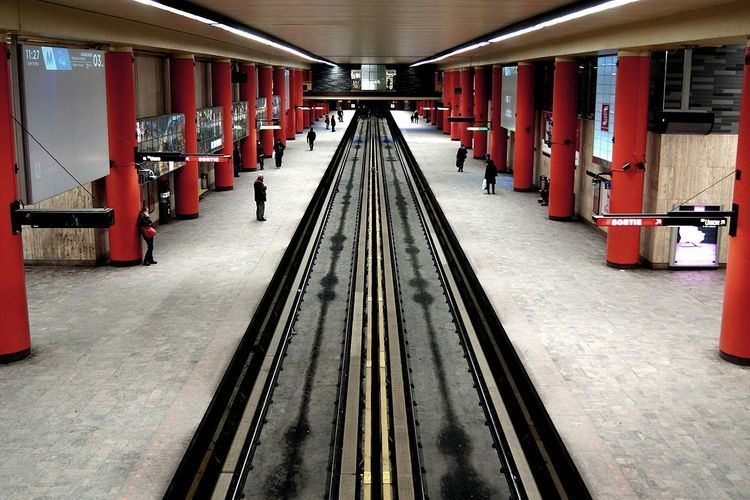Connections STM buses Depth 11 m | Opened 14 October 1966 Province Québec | |
 | ||
Location De Maisonneuve Boulevard at University Street, Montreal
Quebec, Canada Operated by Société de transport de Montréal Architect Crevier, Lemieux, Mercier and Caron Passengers 11,852,430 entrances in 2011, 2nd of 68 Address Montréal, QC H3A 3S6, Canada Similar Peel, Place‑des‑Arts, Bonaventure, Guy‑Concordia, Jean‑Talon | ||
McGill is a station on the Green Line of the Montreal Metro rapid transit system operated by the Société de transport de Montréal (STM). It is located downtown in the borough of Ville-Marie in Montreal, Quebec, Canada. The station opened on October 14, 1966, as part of the original network of the Metro. It is currently the second busiest station (after Berri-UQAM) in the network measured by number of passengers entering the system. Prior to 2002, it was the busiest station in the network.
Contents
Overview
Designed by Crevier, Lemieux, Mercier and Caron, it is a normal side platform station built in open cut under boul. De Maisonneuve, with two ticket halls joined by corridors that surround the platforms. The ticket halls are linked to the platforms by four stairways per platform, including the shortest escalators in the network. The station has large pillars, which were originally painted orange, but painted in beer bottle green color in the late 1990s. In January 2010 the STM repainted the station in its original colors being orange pillars and yellow walls.
As an important part of the underground city, the station has had its mezzanine level substantially enlarged since its opening, by construction of new buildings around the station: the western end of the mezzanine was added with the construction of the Tour BNP and Eaton Centre, while the southern corridor between the ticket halls was added to link the Promenades de la Cathédrale (now known as Promenades Cathédrale) with the station.
No fewer than six buildings are directly connected to the station via underground city, and one, the Eaton Centre, has an entrance directly on the Honoré-Beaugrand platform. (Another access to 2020 de Maisonneuve from the Angrignon platform has been closed.) The station has a further six direct street-level entrances, all of which are integrated into the façades of other buildings.
Among this busy station's amenities include several shops and services directly in the station, including a Tim Hortons, Second Cup, Carlton Cards, a Scotiabank, two Pizza Shops, a web terminal, and MétroVision information screens which displays news, commercials, and the time till the next train. This was second station after Berri-UQAM to have them installed. At one time an "open-concept" branch of the Montreal public library was located next to the exit onto rue Université.
The station has 6 entrances:
690, De Maisonneuve Ouest 640, boul. de Maisonneuve ouest 811, boul. de Maisonneuve ouest 2055, rue University 2021, av. Union 1445, av. UnionArchitecture and art
This station contains several pieces of art. The most prominent is Nicolas Sollogoub's Montreal Scenes Circa 1830, depicting the industrial era in the city as well as its early mayors and civic arms. This set of five stained-glass murals was donated by Macdonald Tobacco. Maurice Savoie created a set of terra cotta murals depicting fruit and flowers, surrounding the entrance to Eaton's (now the Complexe Les Ailes). The construction of the Promenades de la Cathédrale in 1992 brought two new works of art, a light sculpture called Passūs by Murray MacDonald, and an installation of an aerial view of Montreal complete with miniature figures of the buildings, by art collective Les Industries perdues. The latter work is entitled To rise, we must push against the ground onto which we have fallen.
Finally, a tapestry by Kelvin McAvoy depicting the life of James McGill was donated by Canadian Universal Limited Insurance in 1969; however, after being vandalized, it was removed by the company for restoration, and then given as a perpetual loan to McGill University instead, where it is now exhibited at the McLennan Library.
Origin of the name
McGill is named for McGill University. Founded in 1821 with money and on land bequeathed by Scottish-Canadian businessman James McGill, this is one of Canada's most prestigious institutions of higher education.
Renovations
In March 2012, the station is undergoing renovation work that will include the replacement of Travertine tiles covering surfaces of the whole station, spanning over 1,835 square meters. Other work includes replacing the lighting system, fixing columns, beams, and concrete slabs and replacing granite staircases and handrails. The work is scheduled to be done in March 2013.
Future connections
The Mount Royal Tunnel, which currently carries the Deux-Montagnes commuter rail line, passes near the station. Under the Réseau électrique métropolitain proposal, which would convert the line to rapid-transit operation, a connecting station would be built in the McGill area and have connections to this Metro station.
